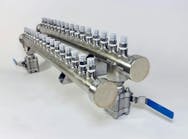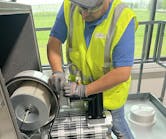By Karen Hanna
More than a year into the COVID-19 pandemic, a plastics industry economist predicts demand for health-care products will continue to grow, even amid lingering supply-chain disruptions.
“From a consumer safety point of view and precautionary points of view, I think the demand will always be positive,” said Perc Pineda, chief economist for the Plastics Industry Association (PLASTICS). He said early runs on essential goods, including personal protective equipment, demonstrated the need for the country to stock up in the future. Creating a robust inventory will take time — and the efforts of plastic parts makers and machinery OEMs.
“I think that’s one of the things that our government actually found out is we cannot really be slacking on the things that we need in an emergency. This might be a one-off event … but I don’t think, really, we would go back to what we were doing before, wherein we’re not stockpiling on things that we would actually need on an emergency basis,” he said.
With the pandemic, personal consumption expenditures took a dive, falling 8 percent from 2019 to 2020, as health-care professionals and patients canceled non-emergency appointments, likes doctor’s visits and dental care.
But over the past year, demand for goods is rocketing back.
“In a way, we will be recovering the production losses during the pandemic in all medical equipment and supplies with the strong bounce-back in the second quarter,” Pineda said.
He predicted slowly slackening growth, with big initial increases to refill the nation’s cupboards followed by a trend toward addressing pent-up demand, especially among institutions, such as hospitals and clinics, and stabilizing supplies at higher-than-customary levels.
“If you look at the second quarter this year, I wouldn’t be surprised [if] we will see a 22.1 percent increase in the production of medical equipment and supplies, but over the third quarter, and by the fourth quarter, we would probably be only seeing 4.2 [percent]; next year, in the industrial production of medical equipment and supplies, we would probably see only a 3.2 percent increase,” he said. Meanwhile, consumption of pharmaceuticals and other medical products could increase 6.6 percent by the fourth quarter this year and 4.8 percent by the fourth quarter next year.
Making up 12 percent of the gross domestic product, the health-care sector accounted for 8.3 percent of the value of all plastic goods created in the U.S., or about $23.6 billion, according to a 2019 PLASTICS estimate. In the last quarter of 2020, about 57 percent of plastics equipment suppliers that responded to a PLASTICS survey supplied goods to the medical and pharmaceutical markets; about 64 percent made packaging.
In 2019, PLASTICS was anticipating a contraction from a decade-long period of growth. It forecasted a 7.7 percent decline in production of plastics machinery; however, Pineda said machine production experienced increases of 1.6 percent in 2019, respectively. With the shutdown, Pineda was bearish on machine production numbers, expecting at one point a 12.2 percent decline.
“But strong demand from the health-care market along with strong demand for consumer essentials and a faster turnaround in key plastics end markets such as housing and automotive contributed to plastic machinery production to increase 2.8 percent in 2020,” he said.
Complicating the economy’s restart are the resin-supply disruptions and labor shortages, as well as continued problems with shipping goods globally.
Pineda predicted resin production, which was clobbered by the winter storms that hit Texas, will return to normal levels in the coming weeks. For resin producers used to being able to shut down for a hurricane and resume 30 days later, the unpredictable storms and unexpected power outages they caused presented little time to prepare, creating chaos that’s lingered for months. Resin sellers and buyers have coped with forces majeure, shortages and huge price increases.
But Pineda expressed optimism those conditions will improve.
“Probably by the end of the second quarter, we would have a better idea of the direction in which the supply shortages will be going. In February, the industrial production of plastics materials and resin decreased by 28 percent. In March, it started going up. And, so, it was up 13 percent in March,” he said.
Though demand for goods has increased, Pineda said labor shortages remain a problem.
“And then if you have civilian workforce who would rather stay at home because they’re afraid of infection, they’re not making as much money, but they could get by, then probably there isn’t really their contribution on the supply side of the economy,” he said.
While the pandemic has exposed the country’s vulnerability when it comes to accessing essential goods, especially from abroad, the idea of localizing production remains a riddle. According to Pineda, in some cases, the cost of shipping from overseas has doubled — from $2,000 or $3,000 for a full shipping container load from Shanghai to $6,000.
But the U.S., which imports about 18 percent of its goods, can’t easily reduce its reliance on overseas markets, said Pineda, citing the labor shortage, high prices, and tax and regulatory policies. Also standing in the way of change: The coming return of normalcy.
“And it’s almost ironic because when that happens, and you make a decision to reshore some business, ‘Oh, what’s the point now that the trade lines are open and prices are actually competitive?’ So, you need to have a lot of money to do it right now and be able to take on the risk of a longer payback, because you don’t know when this thing is actually going to end from a financial point of view,” he said.
While other sectors of the economy have struggled, the pandemic highlights plastics’ importance, Pineda said.
“The idea that plastics is a material that has all these properties, flexibility and cost-effectiveness, etc., etc. ... some of the products just have to be plastics for the health-care sector. I mean, it is what it is. Blood bags is a classic example. You can’t transfuse blood from glass, for example,” he said.
Contact:
Plastics Industry Association, Washington, D.C., 202-974-5200, www.plasticsindustry.org
More on medical parts and plastics
Parts makers step up their processes to meet needs
Health-care market keeps IMM makers busy
Injection unit, machine dedicated for test tubes among new processing technologies
Extruder OEMs respond to changing medical landscape
Auxiliary makers prioritized medical orders during pandemic
Robots shine in clean room duties
University speedily designs and prints nasal swabs
Geisinger’s 3-D lab printed devices to help health care workers stay safe
Beckwood Press designs compression molding equipment for medical devices
Quick deliveries, new products: Husky details COVID-19 response






